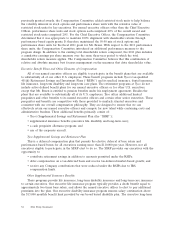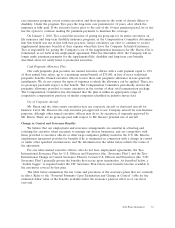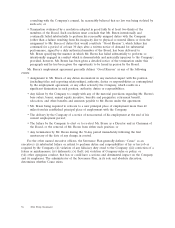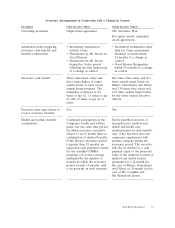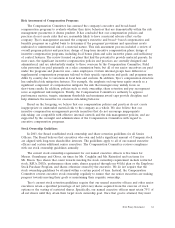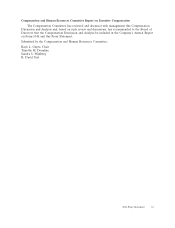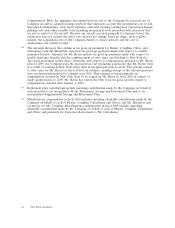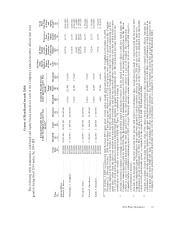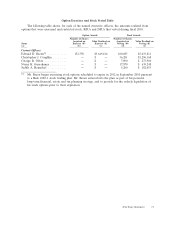ADT 2010 Annual Report Download - page 69
Download and view the complete annual report
Please find page 69 of the 2010 ADT annual report below. You can navigate through the pages in the report by either clicking on the pages listed below, or by using the keyword search tool below to find specific information within the annual report.Risk Assessment of Compensation Programs
The Compensation Committee has assessed the company’s executive and broad-based
compensation programs to evaluate whether they drive behaviors that are demonstrably within the risk
management parameters it deems prudent. It has concluded that our compensation policies and
practices do not create risks that are reasonably likely to have a material adverse effect on the
company. Tyco’s management assessed the company’s executive and broadǁbased compensation and
benefits programs on a global basis to determine if the programs’ provisions and operations create
undesired or unintentional risk of a material nature. This risk assessment process included a review of
overall program policies and practices; design of long-term incentive compensation plans; design of
incentive compensation programs, including local bonus plans and sales incentive plans; and sufficiency
of control features. The review focused on plans that had the potential to provide material payouts. In
most cases, the significant incentive compensation policies and practices are centrally designed and
administered, and are substantially similar to those overseen by the Compensation Committee. Field
sales personnel are paid primarily on a sales commission basis, but all of our senior executives are paid
under the programs and plans for nonǁsales employees. Certain internal groups have different or
supplemental compensation programs tailored to their specific operations and goals, and programs may
differ by country due to variations in local laws and customs. In addition, Tyco’s compensation structure
has embedded risk mitigation features. For example, the emphasis on long-term equity awards as a
significant component of compensation mitigates the risk that managers may unduly focus on
short-term results. In addition, policies such as stock ownership, share retention and pay recoupment
serve as significant risk mitigators. Finally, the Compensation Committee’s authority to approve
performance metrics, targets, minimum thresholds and maximum award caps provide discipline and
help eliminate the incentive for excessive risk-taking behavior.
Based on the foregoing, we believe that our compensation policies and practices do not create
inappropriate or unintended material risk to the company as a whole. We also believe that our
incentive compensation arrangements provide incentives that do not encourage inappropriate
risk-taking; are compatible with effective internal controls and the risk management policies; and are
supported by the oversight and administration of the Compensation Committee with regard to
executive compensation programs.
Stock Ownership Guidelines
In 2003, the Board established stock ownership and share retention guidelines for all Senior
Officers. The Board believes that executives who own and hold a significant amount of Company stock
are aligned with long-term shareholder interests. The guidelines apply to all of our named executive
officers and certain additional senior executives. The Compensation Committee reviews compliance
with our stock ownership guidelines annually.
The current stock ownership requirement for our named executive officers is five times for
Messrs. Gursahaney and Oliver, six times for Mr. Coughlin and Ms. Reinsdorf and ten times for
Mr. Breen. Tyco shares that count towards meeting the stock ownership requirement include restricted
stock, RSUs, DSUs, performance share units, shares acquired through our 401(k) plan or the Employee
Stock Purchase Program, and shares otherwise owned by the executive. We do not require that the
stock ownership guidelines be attained within a certain period of time. Instead, the Compensation
Committee reviews executive stock ownership regularly to ensure that our senior executives are making
progress towards meeting their goals or maintaining their requisite ownership.
Tyco’s current stock retention guidelines require that our named executive officers and other senior
executives retain a specified percentage of net (after-tax) shares acquired from the exercise of stock
options or the vesting of restricted shares. Specifically, our named executive officers must retain 75% of
all net shares until they attain their target stock ownership goal. Once that goal is attained, they must
2011 Proxy Statement 61



